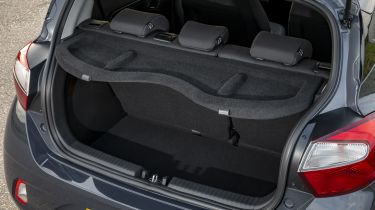Hyundai i10 - Practicality, comfort and boot space
Don’t judge the Hyundai i10 by its size, it can accommodate four adults and there’s a supermini-sized for their luggage

It might measure less than 3.7 metres long, but the Hyundai i10 is a surprisingly spacious little car. When we lived with the i10, we managed to comfortably fit four adults into the car, plus a boot full of luggage. We also appreciate the decent-sized door bins and glovebox, cupholders in the centre console, physical climate controls and tray for a smartphone, which features a wireless charging pad in all but the base model.
Standard kit already includes rear parking sensors, a reversing camera and leather-wrapped steering wheel, but opting for the Premium or N Line trim brings a big-car feel to the cabin and boosts the levels of comfort on offer. They add upgraded cloth upholstery, heated seats and a heated steering wheel, blue LED interior lighting, climate control, a wireless charging pad, and electric folding and heated door mirrors.
Of course, being so small helps make the i10 so easy to thread through crowded city streets and tight multi-storey car parks. Visibility is good, too, and all cars feature height adjustment for the driver’s seat and the steering wheel, but no reach adjustment for the wheel.
Size
At 3,670mm long, 1,680mm wide, and standing 1,480mm tall, the i10 is bigger than its Kia Picanto and Toyota Aygo X rivals in all areas, but not by much. To give a better perspective, the excellent-value Dacia Sandero supermini measures 4,088mm in length, 1,848mm wide and is 1,499mm tall.
Leg room, head room & passenger space
The i10’s wheelbase grew by 40mm for the third-generation model, which, combined with the boxy, upright shape, means there’s lots of space on offer in the little i10. Up front, both head and legroom are generous, so even six-footers shouldn’t have any issues getting comfortable behind the wheel.
We found when we tested with the i10 that four adult occupants can comfortably fit in the i10, while there’s the bonus of being able to fit another passenger in the middle of the rear bench if needed (unlike some other city cars like the Volkswagen up!). That said, we’d only recommend squeezing five people inside for shorter journeys. There are two sets of ISOFIX mounting points for child seats in the back of the i10 (one on each of the outer seats).
Boot
With a total of 252 litres of boot space, the i10 offers good practicality, almost rivalling some superminis. It’s roughly 20 litres up on a Toyota Aygo X and, if you fold the i10’s 60:40-split folding rear seats, you’ll benefit from up to 1,050 litres total load capacity.








